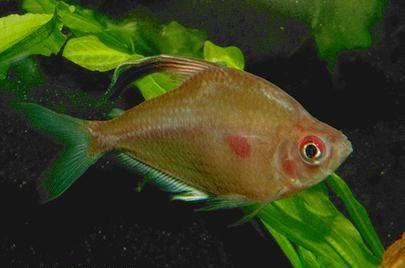Tetra - Bleeding Heart
Scientific Name: Hyphessobrycon erythrostigma
Sat, 19th April, 2025 - 2:43 pm GMT
Sponsor Ads:

Alternative Name
Scientific Name: Hyphessobrycon erythrostigmaBasic Info
Bleeding Heart Tetras usually reach lengths between one and two inches (two and a half and five and a half centimeters). Some develop long, flowing fins. The dorsal fins of males are typically black. All Bleeding Heart Tetras are silvery in color, with a bright red spot where one would imagine the fish's heart to be. Some people maintain that this spot does indeed mark the Bleeding Heart Tetra's heart!
Health
Bleeding Heart Tetras do well in temperatures between 74 and 82 degrees Fahrenheit (24 and 28 degrees Celsius). The pH should be maintained between 5.7 and 7.2. Water quality and cleanliness seem to be particularly important for keeping Bleeding Heart Tetras healthy. Hiding places should be available; driftwood, live plants, and rocks are often used. To avoid stress to your fish, you should keep Bleeding Heart Tetras in pairs or in groups of four or more. Bleeding Heart Tetras often do well on live or frozen bloodworms, brine shrimp, or glass worms. They have been known to accept live tubifex worms as well as frozen plankton and daphnia. Many people keep Bleeding Heart Tetras on freeze-dried foods or flake foods with great success. Breeding Male Bleeding Heart Tetras have long, black dorsal fins. They are rarely, if ever, bred in captivity and no information about their breeding habits is available at this time.Habitat
Fresh water fishBehavior
Bleeding Heart Tetras have dramatic coloration to match their dramatic names. These pretty little fish are one of the largest species of Tetra. The Bleeding Heart Tetra usually swims in the middle ranges of its enclosure. It is a schooling fish that gets along well with others, particularly fish of the same species, and should be kept in groups. Bleeding Heart Tetras will not do well when kept with aggressive fish, which could bully them; small or medium peaceful community fish are normally good tank mates. Bleeding Heart Tetras can make beautiful additions to many community environments. It should be noted that like many Tetras, Bleeding Hearts are often fin nippers and this can be a problem if they are housed in a tank with a fish with flowing fins such as a Betta.Origin
South AmericaHistory
Native to South America, Bleeding Heart Tetras are found in the Amazon River in Columbia.Common Foods
N/ASponsor Ads:
In a time of universal deceit, telling the truth is a revolutionary act. -- George Orwell
Tetra - Bleeding Heart
Coded by: BGID® | ALL RIGHTS RESERVED Copyright © 2000-2025
Disclaimer | Privacy | Report Errors / Contact | Credits










